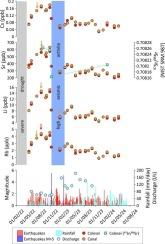气候和地震活动对意大利南阿尔卑斯山东部地下水水文地球化学的综合影响
IF 8
1区 环境科学与生态学
Q1 ENVIRONMENTAL SCIENCES
引用次数: 0
摘要
地下水系统可能受到极端气候和地震等自然事件的干扰,这两种复杂的现象也可能相互作用。这项多学科研究利用水文地质、水文地球化学和地震学数据,调查了它们对南阿尔卑斯山东部(意大利)一个活跃的挤压带地下水的综合影响。在2022年5月至2024年5月期间,每年监测13个春季,每月采样5个春季,以获取化学物理参数、主要和痕量离子。大多数泉水表现为Ca-HCO₃相,表明浅岩溶循环,而两个(Canal和Colesei)泉水表现为Ca-SO₄相,其特征是Na、Cl和温度升高,表明深层来源的贡献。水和溶解气体的稳定同位素证实了所有泉水的大气来源,而87Sr/86Sr、微量元素和地温计进一步支持了Canal和Colesei的深层输入。统计分析(主成分分析和变点检测)确定了地球化学异常可能与(i)长期干旱有关,干旱减少了含水层补给并提高了离子浓度,(ii)地震活动,特别是245公里外的5.8级地震,可能会改变浅层和深层系统之间的混合。这些结果突出了对地下水资源进行综合监测以了解和管理的迫切需要,特别是在面临气候变化和极端事件的构造活跃和人口稠密地区。本文章由计算机程序翻译,如有差异,请以英文原文为准。

Combined impact of climate and seismic activity on groundwater hydrogeochemistry in the Eastern Southern Alps, Italy
Groundwater systems can be perturbed by natural events such as climatic extremes and earthquakes, two complex phenomena that may also interact. This multidisciplinary study investigates their combined effect on groundwater in the Eastern Southern Alps (Italy), an active compressional zone, using hydrogeological, hydrogeochemical, and seismological data. Between May 2022 and May 2024, thirteen springs were monitored annually, with five sampled monthly for chemical-physical parameters, major and trace ions. Most springs show a Ca-HCO₃ facies, indicative of shallow karst circulation, whereas two (Canal and Colesei) exhibit a Ca-SO₄ facies, characterized by elevated Na, Cl, and temperatures, suggesting contributions from deeper sources. Stable isotopes of water and dissolved gases confirm meteoric origin for all springs, while 87Sr/86Sr, trace elements, and geothermometers further support deep inputs at Canal and Colesei. Statistical analyses (Principal Component Analysis and Change Point Detection) identified geochemical anomalies possibly linked to (i) prolonged drought, which reduced aquifer recharge and enhanced ion concentrations, and (ii) seismicity, notably a Mw 5.8 earthquake ∼245 km away, potentially varying mixing between shallow and deep systems. These results highlight the outstanding need for integrated monitoring to understand and manage groundwater resources, particularly in tectonically active and densely populated areas facing climate change and extreme events.
求助全文
通过发布文献求助,成功后即可免费获取论文全文。
去求助
来源期刊

Science of the Total Environment
环境科学-环境科学
CiteScore
17.60
自引率
10.20%
发文量
8726
审稿时长
2.4 months
期刊介绍:
The Science of the Total Environment is an international journal dedicated to scientific research on the environment and its interaction with humanity. It covers a wide range of disciplines and seeks to publish innovative, hypothesis-driven, and impactful research that explores the entire environment, including the atmosphere, lithosphere, hydrosphere, biosphere, and anthroposphere.
The journal's updated Aims & Scope emphasizes the importance of interdisciplinary environmental research with broad impact. Priority is given to studies that advance fundamental understanding and explore the interconnectedness of multiple environmental spheres. Field studies are preferred, while laboratory experiments must demonstrate significant methodological advancements or mechanistic insights with direct relevance to the environment.
 求助内容:
求助内容: 应助结果提醒方式:
应助结果提醒方式:


